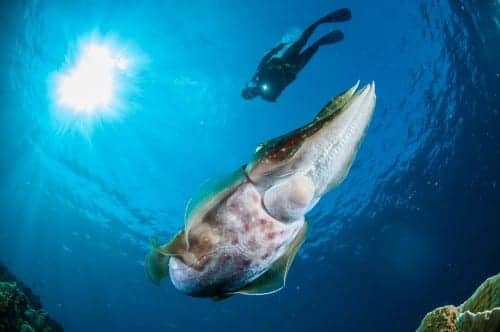Scientists have recognized that noise pollution in our oceans is harmful to marine mammals, affecting their ability to communicate, find mates, and hunt for food. A new study by researchers at Woods Hole Oceanographic Institution (WHOI) and their colleagues examined behavioral responses to sound by cuttlefish, a type of shell-less mollusk related to squid and octopi. Their study findings, published in the December 15, 2014 online edition of the Journal of Experimental Biology, can help decision makers and environmental managers better understand the impacts of noise in the ocean.
“It’s hard to study loudness, or the perception of sound, with animals,” said WHOI biologist T. Aran Mooney, PhD. “Generally, you need to train an animal, such as a chimp or a dolphin, to tell you its perception.”
This was reportedly the first study to identify the acoustic range and minimum sound sensitivity in these marine animals. Obvious challenges to studying sound perception in marine mammals has been limited due to the obvious challenge of interpreting the animal’s responses. Some studies have inferred loudness by measuring how fast an animal responds to sound. But that requires a leap in logic to conclude the animal perceives a sound as louder by measuring how fast the animals runs or swims away from it, said Mooney. His aim was to create a well-designed, controlled study that measured all the right variables to truly map what a cuttlefish hears and its sensitivity to sound.
Mooney and lead author Julia Samson, PhD, a former student in Mooney’s lab, designed a study that relied on previous studies by co-author Roger Hanlon, PhD, of the Marine Biological Laboratory (MBL) in Woods Hole. Hanlon had observed and defined a series of behavioral responses in cuttlefish, such as inking and jetting, mild color change, and twitching. Each response is associated with a perceived level of threat to the animal. For example, inking and jetting is done when cuttlefish predator is close by or they perceive some other threat; mild color change and fin movements demonstrates a reduced level of aversion such as when the animal is startled but not in fear for its life. Twitching is another behavior indicating a very mild response to a stimulus, from which the scientists were able to determine the sound is perceived but that it requires little response.
“What’s cool about the cuttlefish is that you can get all these different graded responses. We could associate these pre-defined behavioral responses with different sounds,” said Mooney. “We didn’t have to train them—they were naturally exhibiting them.”
Cuttlefish reportedly hear in ways similar to fish, and they have an inner ear bone or otolith, which is like tiny grain of sand made of calcium carbonate, the same material corals are made from. According to Mooney, the otolith sits on a bunch of hair cells, and sound waves move the animal back and forth. The animal moves but the otolith apparently slightly lags behind in bending the hair cells, and generating a nerve response in the brain.
According to the study article, the researchers used a test tank at WHOI to measure the responses of 22 cuttlefish to a range of sounds at different frequencies and loudness levels. The tank itself was calibrated twice. First, the sound pressure—which is like the vibration we feel when standing near speakers at a rock concert—was measured at several locations in the tank using one hydrophone. Second, the particle acceleration was measured throughout the tank using two hydrophones to measure the sound pressure difference and derive the acceleration from this difference.
The researchers introduced individual cuttlefish to the tank and gave each some time to acclimate to the new location. Then the researchers would play a sound and score the animal’s behavior. Each animal was exposed to four sounds per day, at random frequencies and levels. Depending on which frequency the animal was exposed to, there were different physical responses.
The research team determined that cuttlefish hear in the same range as fish—approximately 80-1000 Hertz (Hz). This enables them to hear reef sounds, fish predators, and other biological activity—coincidentally the same range where there is lots of anthropogenic noise like seismic testing using air guns, small boat, and commercial shipping traffic.
The study shows that cuttlefish do react behaviorally to sound, especially in the frequencies human are really noisy at around 300 Hz, and the louder the sound the greater the response. The study also suggests that cuttlefish possess loudness perception—a measure not just of sound level, but also frequency—and that they can functionally use the sound to avoid a predator. The researchers determined that cuttlefish are continually perceiving and monitoring the auditory world around them, and can evaluate what’s important and what’s not.
The researchers say their finding is important because most people think invertebrates don’t feel anything or perceive sound. Future studies will take the research out of the controlled environment in the lab and into the ocean to attempt to measure whether anthropogenic noise impacts marine mammals’ reaction to other sounds.
Source: The Journal of Experimental Biology, and Woods Hole Oceanographic Institution (WHOI)
Photo Credit: © Fenkie Sumolang | Dreamstime.com





